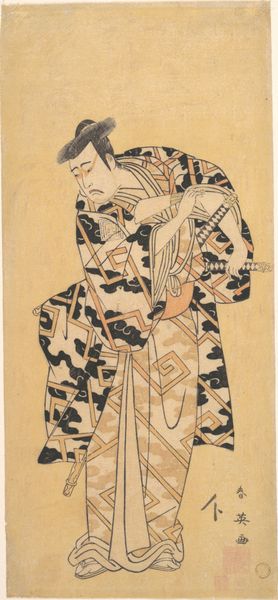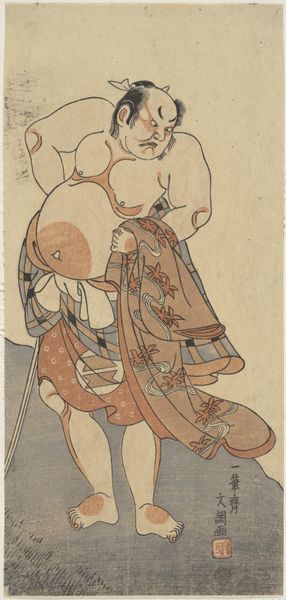
Courtesan on Parade in Falling Snow c. 1765
0:00
0:00
print, woodblock-print
#
portrait
# print
#
asian-art
#
landscape
#
ukiyo-e
#
figuration
#
woodblock-print
#
genre-painting
Dimensions: 26 1/2 × 5 in.
Copyright: Public Domain
Curator: The mood in this ukiyo-e woodblock print feels quietly contemplative, even a little melancholy. Editor: Indeed. This work, created around 1765, is titled "Courtesan on Parade in Falling Snow" and attributed to Suzuki Harunobu. The soft palette and the way the falling snow is rendered gives it an ethereal quality. It feels almost like a memory. Curator: The subject certainly exudes a carefully crafted persona. What symbols can we unlock? Editor: Well, we see the courtesan beneath a large umbrella, head bowed slightly against the elements. Visually, the falling snow creates a sense of isolation and perhaps reflects the precarious position of women in that period, particularly courtesans navigating rigid societal expectations. The umbrella itself feels protective yet confining. It's an interesting study of the confined performance of identity. Curator: Yes, umbrellas as protective canopies recur across different cultures in painted icons and ritual imagery, evoking sacred, protected spaces and high status. I wonder too if there's a hidden, personal narrative at play beyond the explicit societal narrative. What is the nature of performance here, considering what courtesans actually embodied as opposed to just the projections foisted upon them? Editor: That is a great question. The stylized elements inherent to the ukiyo-e genre also contribute, creating distance. This distance prompts critical inquiry of social stratifications reflected in gender dynamics and class distinctions, and it allows a simultaneous aesthetic appreciation and necessary sociohistorical critique. Curator: The artist uses subtle color gradations, and, with the perspective, creates depth. Snowflakes become evocative dots on the picture plane, which feels fresh despite its creation almost three centuries ago. It calls to mind ancient maps of stars in the sky, so that the figure is situated in a vast cosmic constellation even in her fleeting moment captured here. The transience of the snow connects to the transience of our existence. Editor: It's true. Harunobu's approach balances tradition and innovation, reflecting shifts in Edo society at the time. I've noticed, through the image's careful rendering, how deeply he understood human relationships. And despite its aesthetic distance, it draws us in to engage emotionally with its questions of identity and isolation, even today. Curator: Yes, now the art resides in The Art Institute of Chicago. The piece shows the universal condition—mortality, loneliness—through this particular representation of a courtesan. Even in this stylized, specific form, it echoes much older, wider concerns. Editor: A really affecting snapshot from a critical time. Examining this has emphasized for me how context shapes the viewing and significance we can find within such artworks.
Comments
No comments
Be the first to comment and join the conversation on the ultimate creative platform.













